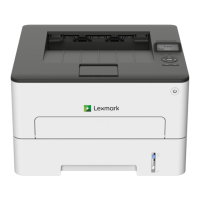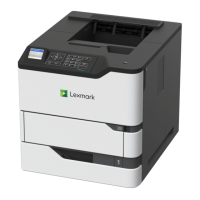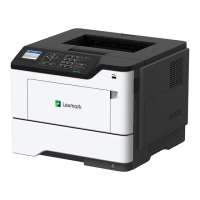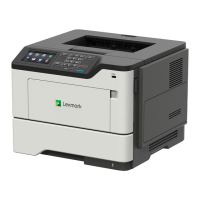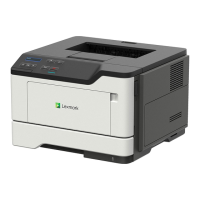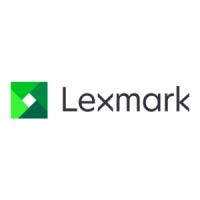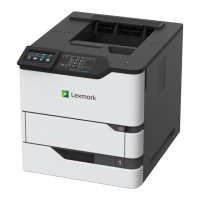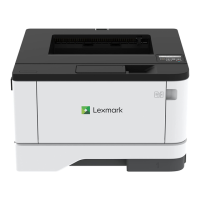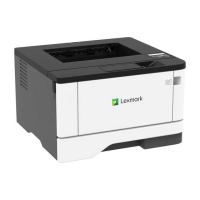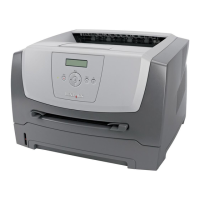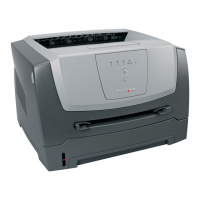Do you have a question about the Lexmark B2236 and is the answer not in the manual?
Explains symbols and notes used in the guide.
Provides important safety statements and warnings related to product usage.
Details resources for setup, usage, and troubleshooting information.
Identifies and labels the main physical components of the printer.
Explains the function of each part of the printer's control panel.
Describes the meaning of different power button and indicator light states.
Provides guidelines for choosing and loading paper for reliable printing.
Details factors like weight, curl, and smoothness affecting print quality.
Gives guidelines for storing paper to maintain quality and prevent jams.
Provides requirements for printer placement, including space and environmental conditions.
Instructs on connecting printer cables and power safely.
Guides on how to load different types of paper and media into the printer.
Explains how to set up custom paper size and type configurations.
Provides instructions for loading paper into the manual feeder.
Guides on obtaining and installing the printer's software package.
Explains how to connect and add the printer to a computer.
Details the process for updating the printer's firmware to the latest version.
Describes how to save and load printer settings.
Guides on connecting the printer to a wireless network.
Explains how to connect the printer using the mobile assistant app.
Provides instructions for connecting via WPS Push Button or PIN methods.
Details how to set up the printer for Wi-Fi Direct peer-to-peer connections.
Explains how to connect mobile devices using Wi-Fi Direct or Wi-Fi.
Guides on connecting computers via Wi-Fi Direct.
Describes how to disconnect the printer from a wireless network.
Explains how to verify the printer's network connection status.
Instructs on printing a page with current printer settings.
Details steps for clearing volatile and non-volatile memory.
Explains how to reset printer settings to factory defaults.
Describes the types of memory in the printer and when to erase them.
Guides on printing documents from a computer.
Covers printing from mobile devices using Lexmark Mobile Print, Mopria, and AirPrint.
Explains how to set up secure printing options like confidential jobs.
Details how to print jobs that are held or confidential.
Guides on printing a list of available fonts.
Explains how to use separator sheets between document copies.
Provides methods to cancel print jobs from the printer or computer.
How to adjust the lightness or darkness of printed text.
Settings related to printer device configuration, including preferences and modes.
Settings related to printer output and print jobs.
Settings related to paper handling, trays, and types.
Settings for network connections, protocols, and ports.
Settings for printer security, login, and access controls.
Options to print various reports like menu settings and device statistics.
Access to diagnostic tools and print quality test pages.
Settings for managing power consumption and print jobs per side.
Settings for connecting to the remote control panel via VNC.
Configuration for supply estimates and custom notifications.
Configuration for setting up email alerts for printer events.
Settings for jam assist, auto-continue, and auto-reboot.
Settings for sleep and hibernate modes, and timeouts.
Settings for sending usage data to Lexmark.
Explains how to reset printer settings to factory defaults.
Configuration options for USB, trays, and paper prompts.
Options to print various reports like menu settings and device statistics.
Options for managing supply usage history and counters.
Settings related to printer language emulations.
Settings for font sharpening and print density.
Settings for panel menus and custom status messages.
Options to clear printer memory and settings.
Information about the printer, such as serial number and location.
Settings for print sides and flip style for two-sided printing.
Controls printing of blank pages within a job.
Settings for keeping pages stacked in sequence for multiple copies.
Options for inserting blank sheets between printed pages.
Settings for printing multiple pages on one sheet.
Specifies the number of copies for each print job.
Sets the printable area on a sheet of paper.
Settings for printer language and print order.
Settings for print resolution and toner darkness.
Settings for PCL fonts, symbol sets, and pitch.
Specifies page orientation for text and graphics.
Controls lines printed per page via PCL data stream.
Enables ending a print job after a period of inactivity.
Settings for image fitting, inversion, scaling, and orientation.
Settings for default paper source and paper size/type.
Settings for universal paper units, width, height, and feed direction.
Specifies paper texture, weight, and orientation.
Settings for network connection type and status.
Settings for Wi-Fi setup via mobile app or printer panel.
Provides instructions for connecting via WPS Push Button or PIN methods.
Settings for DHCP and static IP addresses.
Settings for IPv6, DHCPv6, and autoconfiguration.
Settings for enabling Wi-Fi Direct and configuring network name/password.
Network settings for Ethernet connection, including IP configuration.
Settings for hostname, domain name, and IP address assignment.
Specifies the Domain Name System server address.
Configuration for Simple Network Management Protocol versions and community.
Settings for Internet Protocol Security configuration.
Settings for network authentication using 802.1x.
Settings for Line Printer Daemon configuration.
Configuration for HTTP/HTTPS servers and FTP/TFTP file transfer.
Settings for USB port and PCL SmartSwitch.
Controls access to network sites and email notifications.
Manages user access permissions for printer functions and menus.
Creates and manages local user accounts for printer access.
Configures default values for certificates and manages CA certificates.
Sets limits for failed login attempts and lockout duration.
Settings for confidential jobs, expiration, and duplicate document handling.
Deletes files stored in the printer memory.
Settings for print permission and password length.
Prints a report of the printer's menu settings.
Prints reports on device information, statistics, and profiles.
Prints sample pages to diagnose print quality issues.
How to check the status of printer components and consumables.
Sets up notifications for supplies and paper status.
Configures email alerts for low supplies or paper jams.
How to select and view reports from the control panel.
Information on how to order replacement parts and consumables.
Part number for ordering an imaging unit.
How to reset counters for supplies and parts.
Instructions for safely cleaning the exterior of the printer.
Step-by-step instructions for replacing the toner cartridge.
Step-by-step instructions for replacing the printer's imaging unit.
Step-by-step instructions for replacing the duplex unit.
Step-by-step instructions for replacing the paper tray.
Settings for sleep and hibernate modes to save power.
Tips for reducing paper and toner usage.
Guidelines for safely moving the printer.
Information on how to ship the printer, directing to support website.
Introduction to troubleshooting print quality issues with visual guides.
Troubleshooting steps for when the printer outputs blank or white pages.
Troubleshooting steps for when print is too dark.
Troubleshooting steps for missing or poorly printed fine lines.
Troubleshooting steps for paper that is folded or wrinkled during printing.
Troubleshooting steps for unwanted gray background on prints.
Troubleshooting steps for incorrect or misaligned print margins.
Troubleshooting steps for print that is too light.
Troubleshooting steps for print with uneven patterns or dots.
Troubleshooting steps for paper curling during printing.
Troubleshooting steps for prints that are not straight.
Troubleshooting steps for when the printer outputs solid black pages.
Troubleshooting steps for text or images being cut off on prints.
Troubleshooting steps for toner that rubs off printed pages.
Troubleshooting steps for horizontal light bands on prints.
Troubleshooting steps for vertical light bands on prints.
Troubleshooting steps for vertical white lines on prints.
Troubleshooting steps for vertical dark bands on prints.
Troubleshooting steps for vertical dark lines or streaks on prints.
Troubleshooting steps for vertical streaks with missing print areas.
Troubleshooting steps for repeating print defects and their causes.
Troubleshooting steps for when print jobs fail to print.
Troubleshooting steps for slow print speeds.
Troubleshooting steps for incorrect paper usage.
Troubleshooting steps for held documents failing to print.
Troubleshooting steps for accessing the printer's web interface.
Troubleshooting steps for Wi-Fi connection issues.
How to resolve cartridge region errors.
Information and warnings about using non-Lexmark supplies.
Guidelines and tips to prevent paper jams.
Lists recommended paper types and handling.
Explains how Jam Assist and Jam Recovery affect jam clearance.
Instructions for clearing paper jams from the paper tray.
Instructions for clearing paper jams from the front door.
Instructions for clearing paper jams from the rear door.
Instructions for clearing paper jams from the duplex unit.
Instructions for clearing paper jams from the standard bin.
Instructions for clearing paper jams from the manual feeder.
Troubleshooting for envelope sealing issues during printing.
Troubleshooting steps for collated printing failures.
Troubleshooting steps for recurring paper jams.
Troubleshooting steps if jammed pages are not reprinted.
Instructions for returning Lexmark products for recycling.
Information on Lexmark's efforts in minimizing and recycling packaging.
Basic product details like name, type, and model number.
Information about the publication date and potential errors.
Lists registered trademarks related to Lexmark and other companies.
Information on how to view licensing notices for the product.
Details sound pressure levels for printer operation modes.
Information on recycling programs for electronic products in the EU.
Compliance statement regarding India's E-Waste Rules.
Guidance on proper disposal of the printer and supplies.
Information on Lexmark's cartridge collection and recycling program.
Warning about static-sensitive parts and ESD prevention.
Certification compliance with EPA ENERGY STAR requirements.
Specifies ambient, shipping, and storage temperature ranges.
Compliance information for Class I laser products.
FCC compliance statement for Class B digital devices.
Conformity with EU directives for radio equipment.
RF power and frequency band information for EU and other countries.
Details power consumption in various operating modes (Printing, Ready, Sleep).
Explains the energy-saving Sleep Mode and its timeout settings.
Explains the ultra-low power Hibernate Mode.
How to achieve zero power consumption by disconnecting the power cord.
Guidance on calculating total product energy usage.
Information specific to wireless models.
Details about modular components like wireless adapters.
Information on RF exposure limits and separation distances.
Compliance statement for Canadian RSS standards.
General terms of the limited warranty for the printer.
Details on warranty period start, end, and service.
Exclusions and limitations of the printer's warranty coverage.
Limits Lexmark's liability regarding product performance and damages.
Information on consumer rights that may vary by state.
Explains symbols and notes used in the guide.
Provides important safety statements and warnings related to product usage.
Details resources for setup, usage, and troubleshooting information.
Identifies and labels the main physical components of the printer.
Explains the function of each part of the printer's control panel.
Describes the meaning of different power button and indicator light states.
Provides guidelines for choosing and loading paper for reliable printing.
Details factors like weight, curl, and smoothness affecting print quality.
Gives guidelines for storing paper to maintain quality and prevent jams.
Provides requirements for printer placement, including space and environmental conditions.
Instructs on connecting printer cables and power safely.
Guides on how to load different types of paper and media into the printer.
Explains how to set up custom paper size and type configurations.
Provides instructions for loading paper into the manual feeder.
Guides on obtaining and installing the printer's software package.
Explains how to connect and add the printer to a computer.
Details the process for updating the printer's firmware to the latest version.
Describes how to save and load printer settings.
Guides on connecting the printer to a wireless network.
Explains how to connect the printer using the mobile assistant app.
Provides instructions for connecting via WPS Push Button or PIN methods.
Details how to set up the printer for Wi-Fi Direct peer-to-peer connections.
Explains how to connect mobile devices using Wi-Fi Direct or Wi-Fi.
Guides on connecting computers via Wi-Fi Direct.
Describes how to disconnect the printer from a wireless network.
Explains how to verify the printer's network connection status.
Instructs on printing a page with current printer settings.
Details steps for clearing volatile and non-volatile memory.
Explains how to reset printer settings to factory defaults.
Describes the types of memory in the printer and when to erase them.
Guides on printing documents from a computer.
Covers printing from mobile devices using Lexmark Mobile Print, Mopria, and AirPrint.
Explains how to set up secure printing options like confidential jobs.
Details how to print jobs that are held or confidential.
Guides on printing a list of available fonts.
Explains how to use separator sheets between document copies.
Provides methods to cancel print jobs from the printer or computer.
How to adjust the lightness or darkness of printed text.
Settings related to printer device configuration, including preferences and modes.
Settings related to printer output and print jobs.
Settings related to paper handling, trays, and types.
Settings for network connections, protocols, and ports.
Settings for printer security, login, and access controls.
Options to print various reports like menu settings and device statistics.
Access to diagnostic tools and print quality test pages.
Settings for managing power consumption and print jobs per side.
Settings for connecting to the remote control panel via VNC.
Configuration for supply estimates and custom notifications.
Configuration for setting up email alerts for printer events.
Settings for jam assist, auto-continue, and auto-reboot.
Settings for sleep and hibernate modes, and timeouts.
Settings for sending usage data to Lexmark.
Explains how to reset printer settings to factory defaults.
Configuration options for USB, trays, and paper prompts.
Options to print various reports like menu settings and device statistics.
Options for managing supply usage history and counters.
Settings related to printer language emulations.
Settings for font sharpening and print density.
Settings for panel menus and custom status messages.
Options to clear printer memory and settings.
Information about the printer, such as serial number and location.
Settings for print sides and flip style for two-sided printing.
Controls printing of blank pages within a job.
Settings for keeping pages stacked in sequence for multiple copies.
Options for inserting blank sheets between printed pages.
Settings for printing multiple pages on one sheet.
Specifies the number of copies for each print job.
Sets the printable area on a sheet of paper.
Settings for printer language and print order.
Settings for print resolution and toner darkness.
Settings for PCL fonts, symbol sets, and pitch.
Specifies page orientation for text and graphics.
Controls lines printed per page via PCL data stream.
Enables ending a print job after a period of inactivity.
Settings for image fitting, inversion, scaling, and orientation.
Settings for default paper source and paper size/type.
Settings for universal paper units, width, height, and feed direction.
Specifies paper texture, weight, and orientation.
Settings for network connection type and status.
Settings for Wi-Fi setup via mobile app or printer panel.
Provides instructions for connecting via WPS Push Button or PIN methods.
Settings for DHCP and static IP addresses.
Settings for IPv6, DHCPv6, and autoconfiguration.
Settings for enabling Wi-Fi Direct and configuring network name/password.
Network settings for Ethernet connection, including IP configuration.
Settings for hostname, domain name, and IP address assignment.
Specifies the Domain Name System server address.
Configuration for Simple Network Management Protocol versions and community.
Settings for Internet Protocol Security configuration.
Settings for network authentication using 802.1x.
Settings for Line Printer Daemon configuration.
Configuration for HTTP/HTTPS servers and FTP/TFTP file transfer.
Settings for USB port and PCL SmartSwitch.
Controls access to network sites and email notifications.
Manages user access permissions for printer functions and menus.
Creates and manages local user accounts for printer access.
Configures default values for certificates and manages CA certificates.
Sets limits for failed login attempts and lockout duration.
Settings for confidential jobs, expiration, and duplicate document handling.
Deletes files stored in the printer memory.
Settings for print permission and password length.
Prints a report of the printer's menu settings.
Prints reports on device information, statistics, and profiles.
Prints sample pages to diagnose print quality issues.
How to check the status of printer components and consumables.
Sets up notifications for supplies and paper status.
Configures email alerts for low supplies or paper jams.
How to select and view reports from the control panel.
Information on how to order replacement parts and consumables.
Part number for ordering an imaging unit.
How to reset counters for supplies and parts.
Instructions for safely cleaning the exterior of the printer.
Step-by-step instructions for replacing the toner cartridge.
Step-by-step instructions for replacing the printer's imaging unit.
Step-by-step instructions for replacing the duplex unit.
Step-by-step instructions for replacing the paper tray.
Settings for sleep and hibernate modes to save power.
Tips for reducing paper and toner usage.
Guidelines for safely moving the printer.
Information on how to ship the printer, directing to support website.
Introduction to troubleshooting print quality issues with visual guides.
Troubleshooting steps for when the printer outputs blank or white pages.
Troubleshooting steps for when print is too dark.
Troubleshooting steps for missing or poorly printed fine lines.
Troubleshooting steps for paper that is folded or wrinkled during printing.
Troubleshooting steps for unwanted gray background on prints.
Troubleshooting steps for incorrect or misaligned print margins.
Troubleshooting steps for print that is too light.
Troubleshooting steps for print with uneven patterns or dots.
Troubleshooting steps for paper curling during printing.
Troubleshooting steps for prints that are not straight.
Troubleshooting steps for when the printer outputs solid black pages.
Troubleshooting steps for text or images being cut off on prints.
Troubleshooting steps for toner that rubs off printed pages.
Troubleshooting steps for horizontal light bands on prints.
Troubleshooting steps for vertical light bands on prints.
Troubleshooting steps for vertical white lines on prints.
Troubleshooting steps for vertical dark bands on prints.
Troubleshooting steps for vertical dark lines or streaks on prints.
Troubleshooting steps for vertical streaks with missing print areas.
Troubleshooting steps for repeating print defects and their causes.
Troubleshooting steps for when print jobs fail to print.
Troubleshooting steps for slow print speeds.
Troubleshooting steps for incorrect paper usage.
Troubleshooting steps for held documents failing to print.
Troubleshooting steps for accessing the printer's web interface.
Troubleshooting steps for Wi-Fi connection issues.
How to resolve cartridge region errors.
Information and warnings about using non-Lexmark supplies.
Guidelines and tips to prevent paper jams.
Lists recommended paper types and handling.
Explains how Jam Assist and Jam Recovery affect jam clearance.
Instructions for clearing paper jams from the paper tray.
Instructions for clearing paper jams from the front door.
Instructions for clearing paper jams from the rear door.
Instructions for clearing paper jams from the duplex unit.
Instructions for clearing paper jams from the standard bin.
Instructions for clearing paper jams from the manual feeder.
Troubleshooting for envelope sealing issues during printing.
Troubleshooting steps for collated printing failures.
Troubleshooting steps for recurring paper jams.
Troubleshooting steps if jammed pages are not reprinted.
Instructions for returning Lexmark products for recycling.
Information on Lexmark's efforts in minimizing and recycling packaging.
Basic product details like name, type, and model number.
Information about the publication date and potential errors.
Lists registered trademarks related to Lexmark and other companies.
Information on how to view licensing notices for the product.
Details sound pressure levels for printer operation modes.
Information on recycling programs for electronic products in the EU.
Compliance statement regarding India's E-Waste Rules.
Guidance on proper disposal of the printer and supplies.
Information on Lexmark's cartridge collection and recycling program.
Warning about static-sensitive parts and ESD prevention.
Certification compliance with EPA ENERGY STAR requirements.
Specifies ambient, shipping, and storage temperature ranges.
Compliance information for Class I laser products.
FCC compliance statement for Class B digital devices.
Conformity with EU directives for radio equipment.
RF power and frequency band information for EU and other countries.
Details power consumption in various operating modes (Printing, Ready, Sleep).
Explains the energy-saving Sleep Mode and its timeout settings.
Explains the ultra-low power Hibernate Mode.
How to achieve zero power consumption by disconnecting the power cord.
Guidance on calculating total product energy usage.
Information specific to wireless models.
Details about modular components like wireless adapters.
Information on RF exposure limits and separation distances.
Compliance statement for Canadian RSS standards.
General terms of the limited warranty for the printer.
Details on warranty period start, end, and service.
Exclusions and limitations of the printer's warranty coverage.
Limits Lexmark's liability regarding product performance and damages.
Information on consumer rights that may vary by state.
| Print Technology | Monochrome Laser |
|---|---|
| Print Resolution | 1200 x 1200 dpi |
| Memory | 256 MB |
| Connectivity | USB, Ethernet |
| Standard Input Capacity | 250 sheets |
| First Page Out Time | As fast as 8.5 seconds |
| Network Ready | Yes |
| Operating System Compatibility | Windows, Mac, Linux |
| Print Speed | Up to 36 ppm |
| Processor Speed | 1 GHz |
| Monthly Duty Cycle | 50000 pages |
| Standard Output Capacity | 150 sheets |
| Media Types Supported | Card Stock, Envelopes, Labels, Plain Paper |
| Duplex Printing | Automatic |
